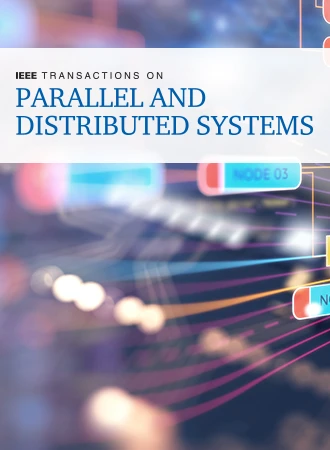DFU-E:边缘DSP和AI应用的数据流架构
IF 5.6
2区 计算机科学
Q1 COMPUTER SCIENCE, THEORY & METHODS
IEEE Transactions on Parallel and Distributed Systems
Pub Date : 2025-03-28
DOI:10.1109/TPDS.2025.3555329
引用次数: 0
摘要
边缘计算旨在实现快速、实时的数据处理、分析和靠近数据源的存储。然而,边缘计算平台往往受到有限的处理能力和效率的限制。DFU-E是一种基于数据流的加速器,专为满足边缘数字信号处理(DSP)和人工智能(AI)应用的需求而设计。我们的设计通过三个主要创新满足了现实世界的需求。首先,为了适应边缘使用的各种算法,我们提出了一种能够利用任务级、指令块级、指令级和数据级并行性的多层数据流机制。其次,我们开发了一个边缘数据流架构,其中包括定制的处理元件(PE)阵列、存储器和针对多层数据流机制优化的片上网络微架构。第三,我们设计了一个边缘数据流软件堆栈,通过算子融合、数据流图映射和任务调度实现自动优化。我们使用具有代表性的现实DSP和AI应用程序进行评估。与英伟达最先进的边缘计算处理器相比,DFU-E实现了高达1.42倍的几何平均性能提升和1.27倍的能效提升。本文章由计算机程序翻译,如有差异,请以英文原文为准。
DFU-E: A Dataflow Architecture for Edge DSP and AI Applications
Edge computing aims to enable swift, real-time data processing, analysis, and storage close to the data source. However, edge computing platforms are often constrained by limited processing power and efficiency. This paper presents DFU-E, a dataflow-based accelerator specifically designed to meet the demands of edge digital signal processing (DSP) and artificial intelligence (AI) applications. Our design addresses real-world requirements with three main innovations. First, to accommodate the diverse algorithms utilized at the edge, we propose a multi-layer dataflow mechanism capable of exploiting task-level, instruction block-level, instruction-level, and data-level parallelism. Second, we develop an edge dataflow architecture that includes a customized processing element (PE) array, memory, and on-chip network microarchitecture optimized for the multi-layer dataflow mechanism. Third, we design an edge dataflow software stack that enables automatic optimizations through operator fusion, dataflow graph mapping, and task scheduling. We utilize representative real-world DSP and AI applications for evaluation. Comparing with Nvidia's state-of-the-art edge computing processor, DFU-E achieves up to 1.42× geometric mean performance improvement and 1.27× energy efficiency improvement.
求助全文
通过发布文献求助,成功后即可免费获取论文全文。
去求助
来源期刊

IEEE Transactions on Parallel and Distributed Systems
工程技术-工程:电子与电气
CiteScore
11.00
自引率
9.40%
发文量
281
审稿时长
5.6 months
期刊介绍:
IEEE Transactions on Parallel and Distributed Systems (TPDS) is published monthly. It publishes a range of papers, comments on previously published papers, and survey articles that deal with the parallel and distributed systems research areas of current importance to our readers. Particular areas of interest include, but are not limited to:
a) Parallel and distributed algorithms, focusing on topics such as: models of computation; numerical, combinatorial, and data-intensive parallel algorithms, scalability of algorithms and data structures for parallel and distributed systems, communication and synchronization protocols, network algorithms, scheduling, and load balancing.
b) Applications of parallel and distributed computing, including computational and data-enabled science and engineering, big data applications, parallel crowd sourcing, large-scale social network analysis, management of big data, cloud and grid computing, scientific and biomedical applications, mobile computing, and cyber-physical systems.
c) Parallel and distributed architectures, including architectures for instruction-level and thread-level parallelism; design, analysis, implementation, fault resilience and performance measurements of multiple-processor systems; multicore processors, heterogeneous many-core systems; petascale and exascale systems designs; novel big data architectures; special purpose architectures, including graphics processors, signal processors, network processors, media accelerators, and other special purpose processors and accelerators; impact of technology on architecture; network and interconnect architectures; parallel I/O and storage systems; architecture of the memory hierarchy; power-efficient and green computing architectures; dependable architectures; and performance modeling and evaluation.
d) Parallel and distributed software, including parallel and multicore programming languages and compilers, runtime systems, operating systems, Internet computing and web services, resource management including green computing, middleware for grids, clouds, and data centers, libraries, performance modeling and evaluation, parallel programming paradigms, and programming environments and tools.
 求助内容:
求助内容: 应助结果提醒方式:
应助结果提醒方式:


